Unsustainable Tourism in Developing Nations: Environmental Concerns
VerifiedAdded on 2023/06/07
|13
|2926
|252
AI Summary
This study discusses the negative impact of the tourism sector on the environment in developing nations. It highlights the reasons why tourism is unsustainable and the various environmental concerns. The study also suggests measures for sustainable tourism.
Contribute Materials
Your contribution can guide someone’s learning journey. Share your
documents today.
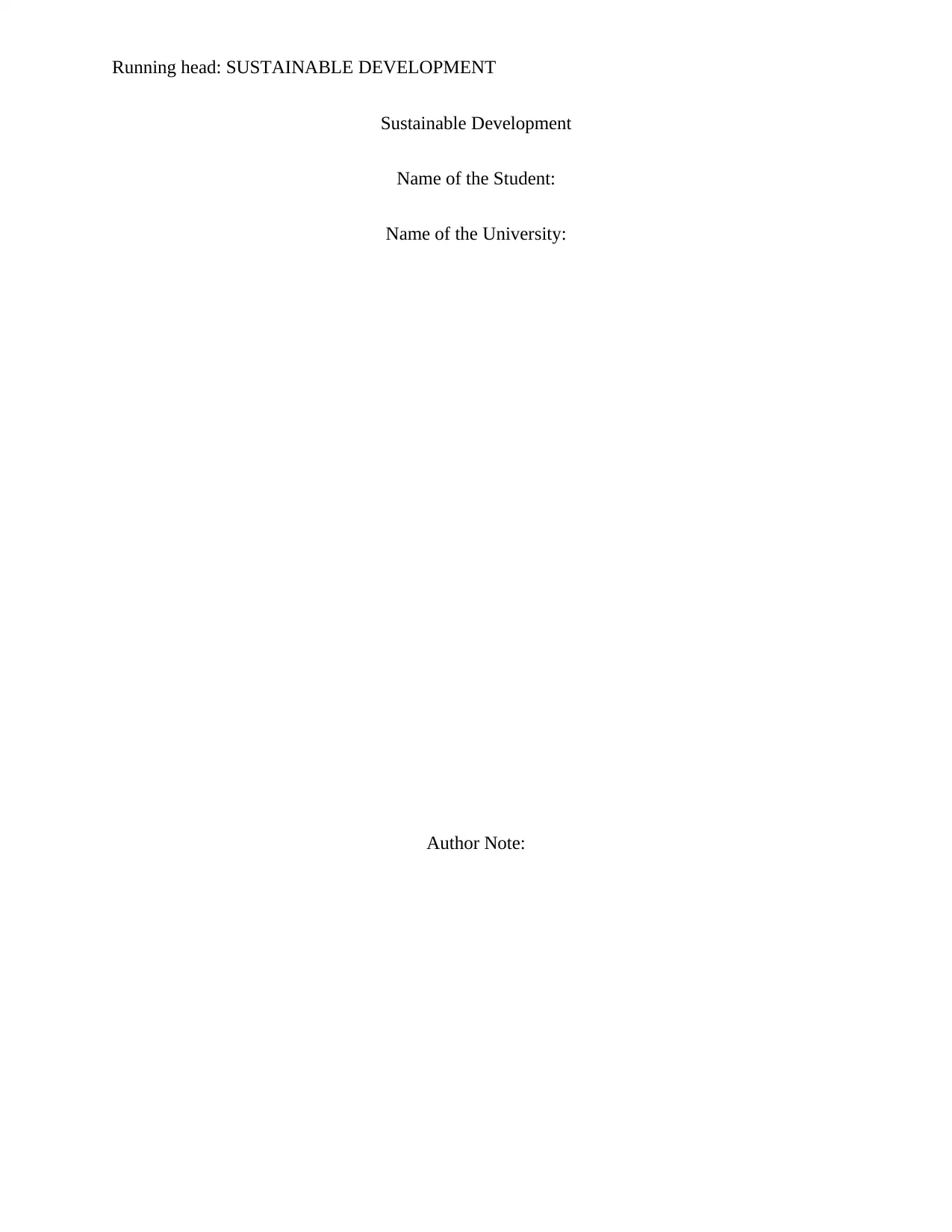
Running head: SUSTAINABLE DEVELOPMENT
Sustainable Development
Name of the Student:
Name of the University:
Author Note:
Sustainable Development
Name of the Student:
Name of the University:
Author Note:
Secure Best Marks with AI Grader
Need help grading? Try our AI Grader for instant feedback on your assignments.
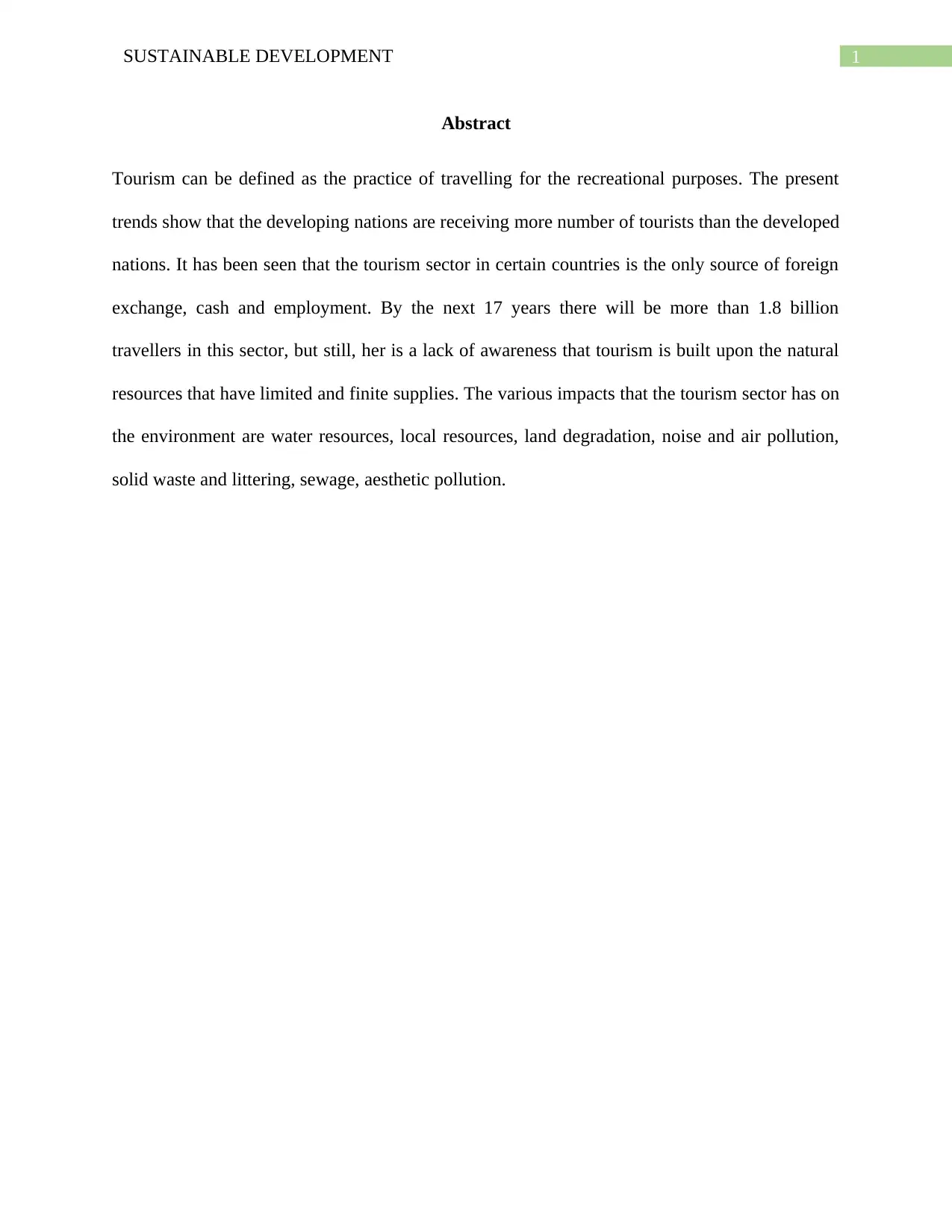
1SUSTAINABLE DEVELOPMENT
Abstract
Tourism can be defined as the practice of travelling for the recreational purposes. The present
trends show that the developing nations are receiving more number of tourists than the developed
nations. It has been seen that the tourism sector in certain countries is the only source of foreign
exchange, cash and employment. By the next 17 years there will be more than 1.8 billion
travellers in this sector, but still, her is a lack of awareness that tourism is built upon the natural
resources that have limited and finite supplies. The various impacts that the tourism sector has on
the environment are water resources, local resources, land degradation, noise and air pollution,
solid waste and littering, sewage, aesthetic pollution.
Abstract
Tourism can be defined as the practice of travelling for the recreational purposes. The present
trends show that the developing nations are receiving more number of tourists than the developed
nations. It has been seen that the tourism sector in certain countries is the only source of foreign
exchange, cash and employment. By the next 17 years there will be more than 1.8 billion
travellers in this sector, but still, her is a lack of awareness that tourism is built upon the natural
resources that have limited and finite supplies. The various impacts that the tourism sector has on
the environment are water resources, local resources, land degradation, noise and air pollution,
solid waste and littering, sewage, aesthetic pollution.
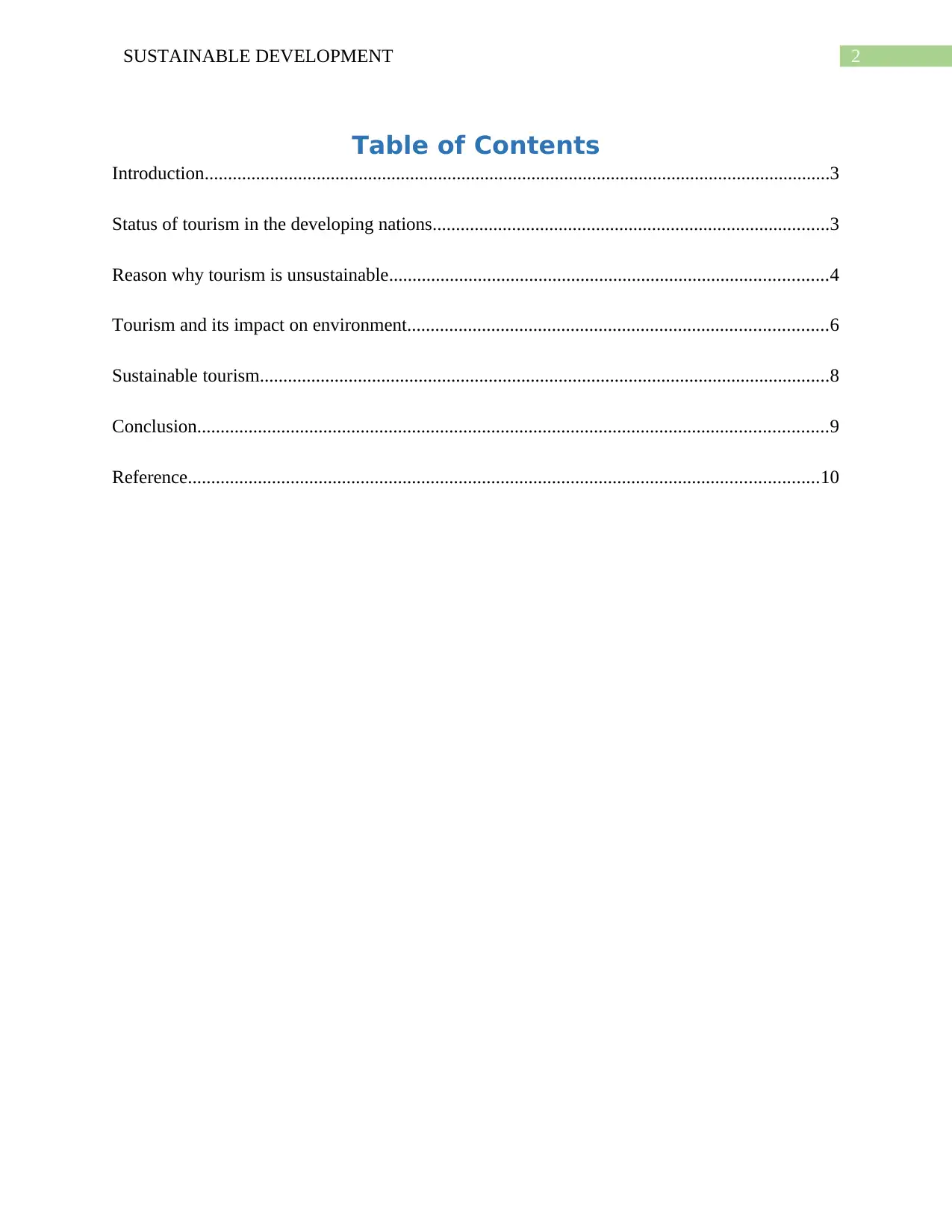
2SUSTAINABLE DEVELOPMENT
Table of Contents
Introduction......................................................................................................................................3
Status of tourism in the developing nations.....................................................................................3
Reason why tourism is unsustainable..............................................................................................4
Tourism and its impact on environment..........................................................................................6
Sustainable tourism..........................................................................................................................8
Conclusion.......................................................................................................................................9
Reference.......................................................................................................................................10
Table of Contents
Introduction......................................................................................................................................3
Status of tourism in the developing nations.....................................................................................3
Reason why tourism is unsustainable..............................................................................................4
Tourism and its impact on environment..........................................................................................6
Sustainable tourism..........................................................................................................................8
Conclusion.......................................................................................................................................9
Reference.......................................................................................................................................10
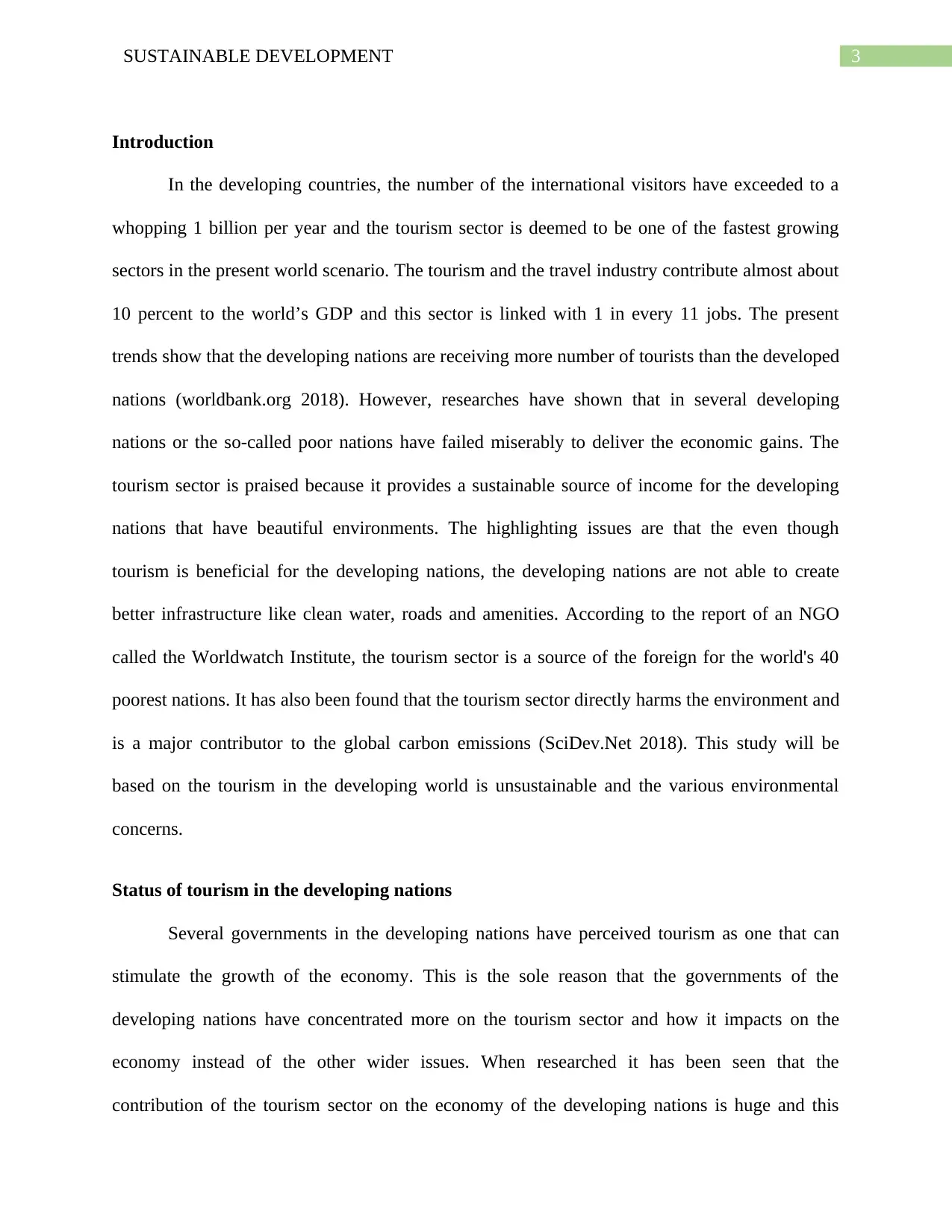
3SUSTAINABLE DEVELOPMENT
Introduction
In the developing countries, the number of the international visitors have exceeded to a
whopping 1 billion per year and the tourism sector is deemed to be one of the fastest growing
sectors in the present world scenario. The tourism and the travel industry contribute almost about
10 percent to the world’s GDP and this sector is linked with 1 in every 11 jobs. The present
trends show that the developing nations are receiving more number of tourists than the developed
nations (worldbank.org 2018). However, researches have shown that in several developing
nations or the so-called poor nations have failed miserably to deliver the economic gains. The
tourism sector is praised because it provides a sustainable source of income for the developing
nations that have beautiful environments. The highlighting issues are that the even though
tourism is beneficial for the developing nations, the developing nations are not able to create
better infrastructure like clean water, roads and amenities. According to the report of an NGO
called the Worldwatch Institute, the tourism sector is a source of the foreign for the world's 40
poorest nations. It has also been found that the tourism sector directly harms the environment and
is a major contributor to the global carbon emissions (SciDev.Net 2018). This study will be
based on the tourism in the developing world is unsustainable and the various environmental
concerns.
Status of tourism in the developing nations
Several governments in the developing nations have perceived tourism as one that can
stimulate the growth of the economy. This is the sole reason that the governments of the
developing nations have concentrated more on the tourism sector and how it impacts on the
economy instead of the other wider issues. When researched it has been seen that the
contribution of the tourism sector on the economy of the developing nations is huge and this
Introduction
In the developing countries, the number of the international visitors have exceeded to a
whopping 1 billion per year and the tourism sector is deemed to be one of the fastest growing
sectors in the present world scenario. The tourism and the travel industry contribute almost about
10 percent to the world’s GDP and this sector is linked with 1 in every 11 jobs. The present
trends show that the developing nations are receiving more number of tourists than the developed
nations (worldbank.org 2018). However, researches have shown that in several developing
nations or the so-called poor nations have failed miserably to deliver the economic gains. The
tourism sector is praised because it provides a sustainable source of income for the developing
nations that have beautiful environments. The highlighting issues are that the even though
tourism is beneficial for the developing nations, the developing nations are not able to create
better infrastructure like clean water, roads and amenities. According to the report of an NGO
called the Worldwatch Institute, the tourism sector is a source of the foreign for the world's 40
poorest nations. It has also been found that the tourism sector directly harms the environment and
is a major contributor to the global carbon emissions (SciDev.Net 2018). This study will be
based on the tourism in the developing world is unsustainable and the various environmental
concerns.
Status of tourism in the developing nations
Several governments in the developing nations have perceived tourism as one that can
stimulate the growth of the economy. This is the sole reason that the governments of the
developing nations have concentrated more on the tourism sector and how it impacts on the
economy instead of the other wider issues. When researched it has been seen that the
contribution of the tourism sector on the economy of the developing nations is huge and this
Secure Best Marks with AI Grader
Need help grading? Try our AI Grader for instant feedback on your assignments.
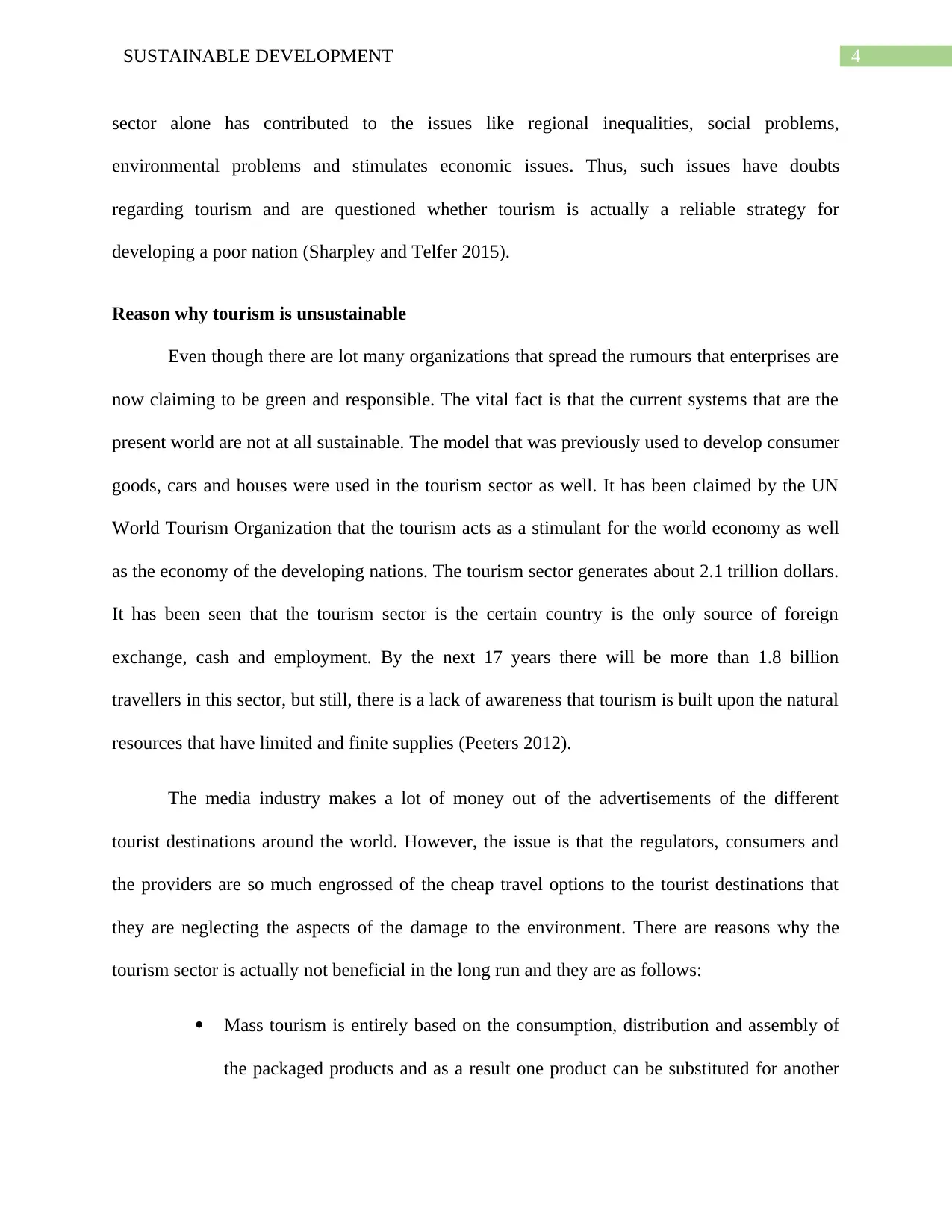
4SUSTAINABLE DEVELOPMENT
sector alone has contributed to the issues like regional inequalities, social problems,
environmental problems and stimulates economic issues. Thus, such issues have doubts
regarding tourism and are questioned whether tourism is actually a reliable strategy for
developing a poor nation (Sharpley and Telfer 2015).
Reason why tourism is unsustainable
Even though there are lot many organizations that spread the rumours that enterprises are
now claiming to be green and responsible. The vital fact is that the current systems that are the
present world are not at all sustainable. The model that was previously used to develop consumer
goods, cars and houses were used in the tourism sector as well. It has been claimed by the UN
World Tourism Organization that the tourism acts as a stimulant for the world economy as well
as the economy of the developing nations. The tourism sector generates about 2.1 trillion dollars.
It has been seen that the tourism sector is the certain country is the only source of foreign
exchange, cash and employment. By the next 17 years there will be more than 1.8 billion
travellers in this sector, but still, there is a lack of awareness that tourism is built upon the natural
resources that have limited and finite supplies (Peeters 2012).
The media industry makes a lot of money out of the advertisements of the different
tourist destinations around the world. However, the issue is that the regulators, consumers and
the providers are so much engrossed of the cheap travel options to the tourist destinations that
they are neglecting the aspects of the damage to the environment. There are reasons why the
tourism sector is actually not beneficial in the long run and they are as follows:
Mass tourism is entirely based on the consumption, distribution and assembly of
the packaged products and as a result one product can be substituted for another
sector alone has contributed to the issues like regional inequalities, social problems,
environmental problems and stimulates economic issues. Thus, such issues have doubts
regarding tourism and are questioned whether tourism is actually a reliable strategy for
developing a poor nation (Sharpley and Telfer 2015).
Reason why tourism is unsustainable
Even though there are lot many organizations that spread the rumours that enterprises are
now claiming to be green and responsible. The vital fact is that the current systems that are the
present world are not at all sustainable. The model that was previously used to develop consumer
goods, cars and houses were used in the tourism sector as well. It has been claimed by the UN
World Tourism Organization that the tourism acts as a stimulant for the world economy as well
as the economy of the developing nations. The tourism sector generates about 2.1 trillion dollars.
It has been seen that the tourism sector is the certain country is the only source of foreign
exchange, cash and employment. By the next 17 years there will be more than 1.8 billion
travellers in this sector, but still, there is a lack of awareness that tourism is built upon the natural
resources that have limited and finite supplies (Peeters 2012).
The media industry makes a lot of money out of the advertisements of the different
tourist destinations around the world. However, the issue is that the regulators, consumers and
the providers are so much engrossed of the cheap travel options to the tourist destinations that
they are neglecting the aspects of the damage to the environment. There are reasons why the
tourism sector is actually not beneficial in the long run and they are as follows:
Mass tourism is entirely based on the consumption, distribution and assembly of
the packaged products and as a result one product can be substituted for another
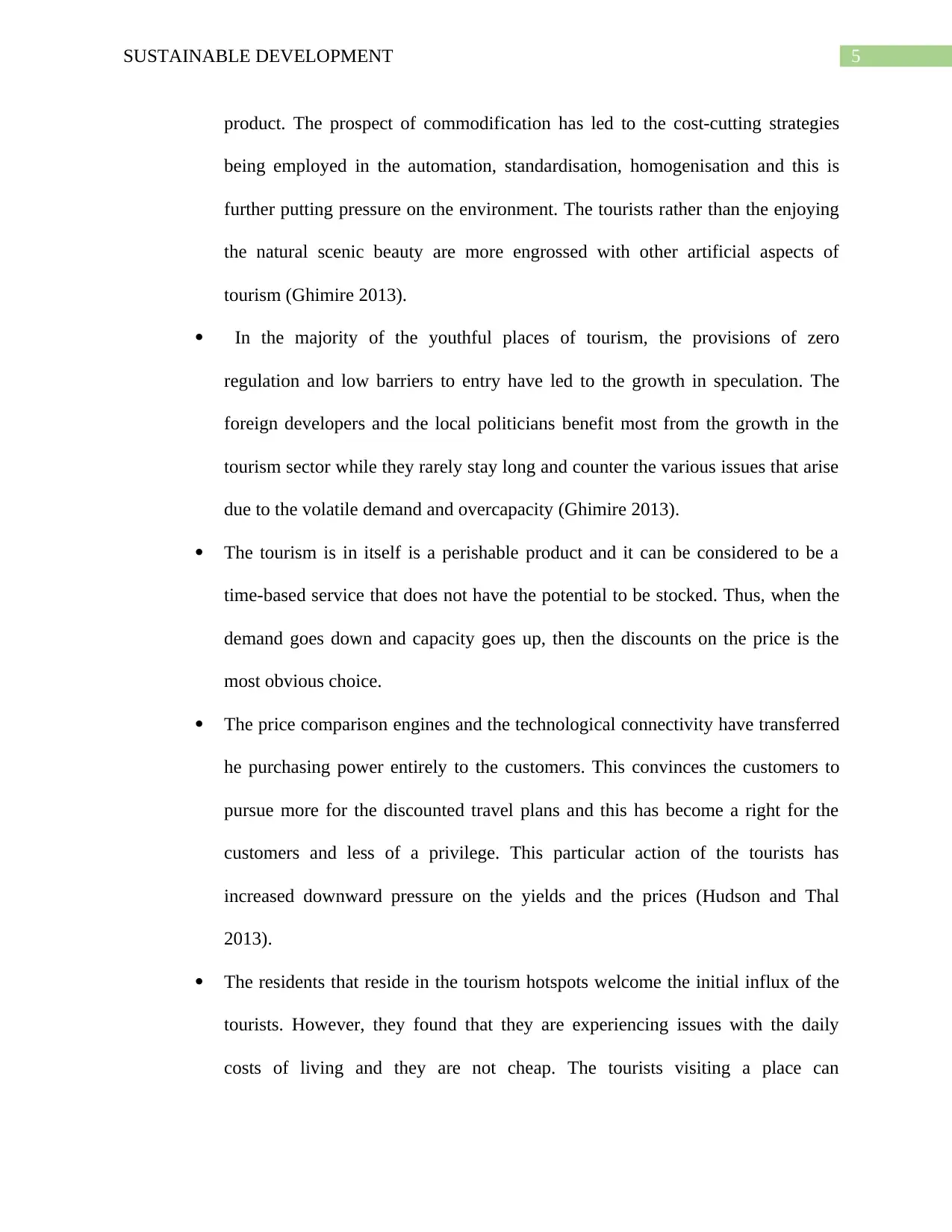
5SUSTAINABLE DEVELOPMENT
product. The prospect of commodification has led to the cost-cutting strategies
being employed in the automation, standardisation, homogenisation and this is
further putting pressure on the environment. The tourists rather than the enjoying
the natural scenic beauty are more engrossed with other artificial aspects of
tourism (Ghimire 2013).
In the majority of the youthful places of tourism, the provisions of zero
regulation and low barriers to entry have led to the growth in speculation. The
foreign developers and the local politicians benefit most from the growth in the
tourism sector while they rarely stay long and counter the various issues that arise
due to the volatile demand and overcapacity (Ghimire 2013).
The tourism is in itself is a perishable product and it can be considered to be a
time-based service that does not have the potential to be stocked. Thus, when the
demand goes down and capacity goes up, then the discounts on the price is the
most obvious choice.
The price comparison engines and the technological connectivity have transferred
he purchasing power entirely to the customers. This convinces the customers to
pursue more for the discounted travel plans and this has become a right for the
customers and less of a privilege. This particular action of the tourists has
increased downward pressure on the yields and the prices (Hudson and Thal
2013).
The residents that reside in the tourism hotspots welcome the initial influx of the
tourists. However, they found that they are experiencing issues with the daily
costs of living and they are not cheap. The tourists visiting a place can
product. The prospect of commodification has led to the cost-cutting strategies
being employed in the automation, standardisation, homogenisation and this is
further putting pressure on the environment. The tourists rather than the enjoying
the natural scenic beauty are more engrossed with other artificial aspects of
tourism (Ghimire 2013).
In the majority of the youthful places of tourism, the provisions of zero
regulation and low barriers to entry have led to the growth in speculation. The
foreign developers and the local politicians benefit most from the growth in the
tourism sector while they rarely stay long and counter the various issues that arise
due to the volatile demand and overcapacity (Ghimire 2013).
The tourism is in itself is a perishable product and it can be considered to be a
time-based service that does not have the potential to be stocked. Thus, when the
demand goes down and capacity goes up, then the discounts on the price is the
most obvious choice.
The price comparison engines and the technological connectivity have transferred
he purchasing power entirely to the customers. This convinces the customers to
pursue more for the discounted travel plans and this has become a right for the
customers and less of a privilege. This particular action of the tourists has
increased downward pressure on the yields and the prices (Hudson and Thal
2013).
The residents that reside in the tourism hotspots welcome the initial influx of the
tourists. However, they found that they are experiencing issues with the daily
costs of living and they are not cheap. The tourists visiting a place can
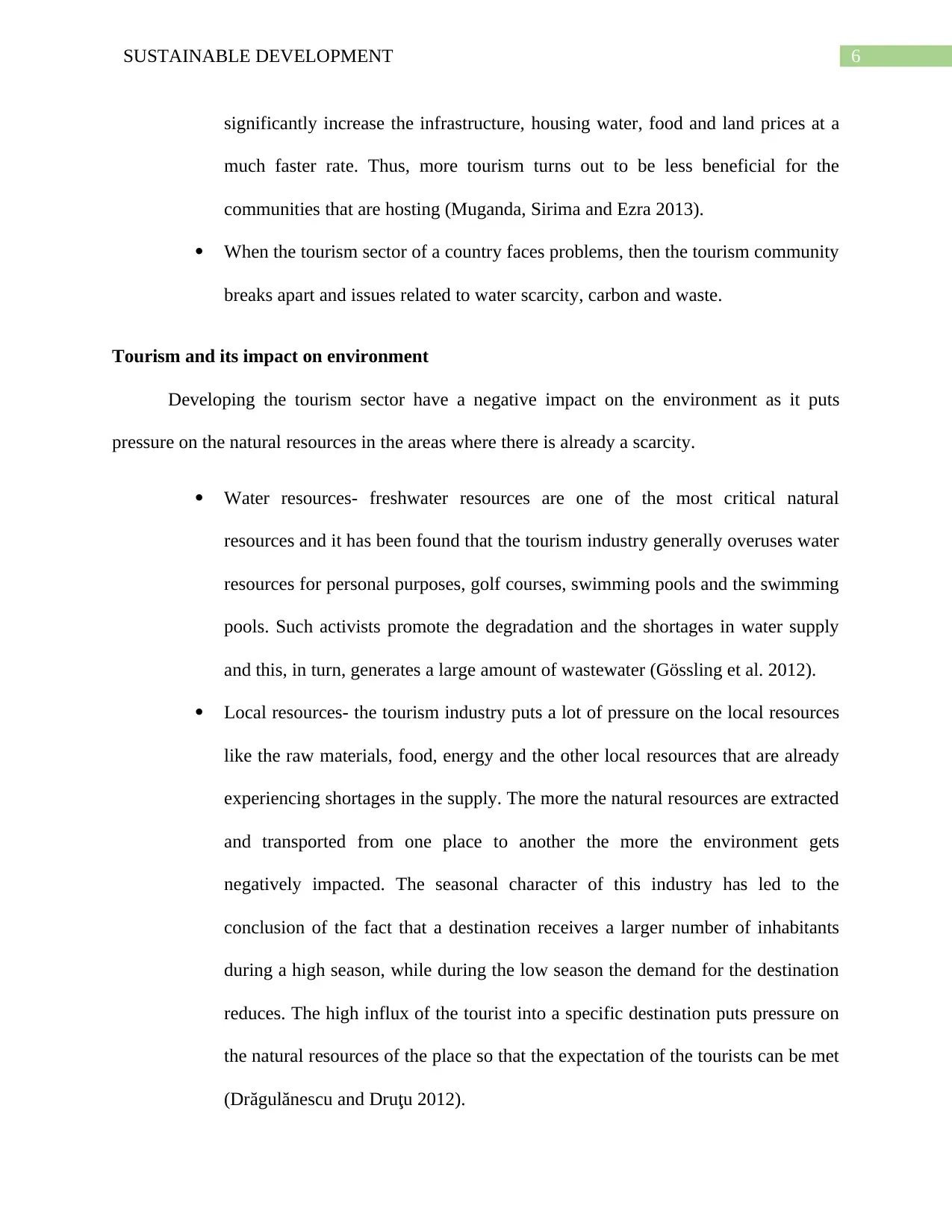
6SUSTAINABLE DEVELOPMENT
significantly increase the infrastructure, housing water, food and land prices at a
much faster rate. Thus, more tourism turns out to be less beneficial for the
communities that are hosting (Muganda, Sirima and Ezra 2013).
When the tourism sector of a country faces problems, then the tourism community
breaks apart and issues related to water scarcity, carbon and waste.
Tourism and its impact on environment
Developing the tourism sector have a negative impact on the environment as it puts
pressure on the natural resources in the areas where there is already a scarcity.
Water resources- freshwater resources are one of the most critical natural
resources and it has been found that the tourism industry generally overuses water
resources for personal purposes, golf courses, swimming pools and the swimming
pools. Such activists promote the degradation and the shortages in water supply
and this, in turn, generates a large amount of wastewater (Gössling et al. 2012).
Local resources- the tourism industry puts a lot of pressure on the local resources
like the raw materials, food, energy and the other local resources that are already
experiencing shortages in the supply. The more the natural resources are extracted
and transported from one place to another the more the environment gets
negatively impacted. The seasonal character of this industry has led to the
conclusion of the fact that a destination receives a larger number of inhabitants
during a high season, while during the low season the demand for the destination
reduces. The high influx of the tourist into a specific destination puts pressure on
the natural resources of the place so that the expectation of the tourists can be met
(Drăgulănescu and Druţu 2012).
significantly increase the infrastructure, housing water, food and land prices at a
much faster rate. Thus, more tourism turns out to be less beneficial for the
communities that are hosting (Muganda, Sirima and Ezra 2013).
When the tourism sector of a country faces problems, then the tourism community
breaks apart and issues related to water scarcity, carbon and waste.
Tourism and its impact on environment
Developing the tourism sector have a negative impact on the environment as it puts
pressure on the natural resources in the areas where there is already a scarcity.
Water resources- freshwater resources are one of the most critical natural
resources and it has been found that the tourism industry generally overuses water
resources for personal purposes, golf courses, swimming pools and the swimming
pools. Such activists promote the degradation and the shortages in water supply
and this, in turn, generates a large amount of wastewater (Gössling et al. 2012).
Local resources- the tourism industry puts a lot of pressure on the local resources
like the raw materials, food, energy and the other local resources that are already
experiencing shortages in the supply. The more the natural resources are extracted
and transported from one place to another the more the environment gets
negatively impacted. The seasonal character of this industry has led to the
conclusion of the fact that a destination receives a larger number of inhabitants
during a high season, while during the low season the demand for the destination
reduces. The high influx of the tourist into a specific destination puts pressure on
the natural resources of the place so that the expectation of the tourists can be met
(Drăgulănescu and Druţu 2012).
Paraphrase This Document
Need a fresh take? Get an instant paraphrase of this document with our AI Paraphraser
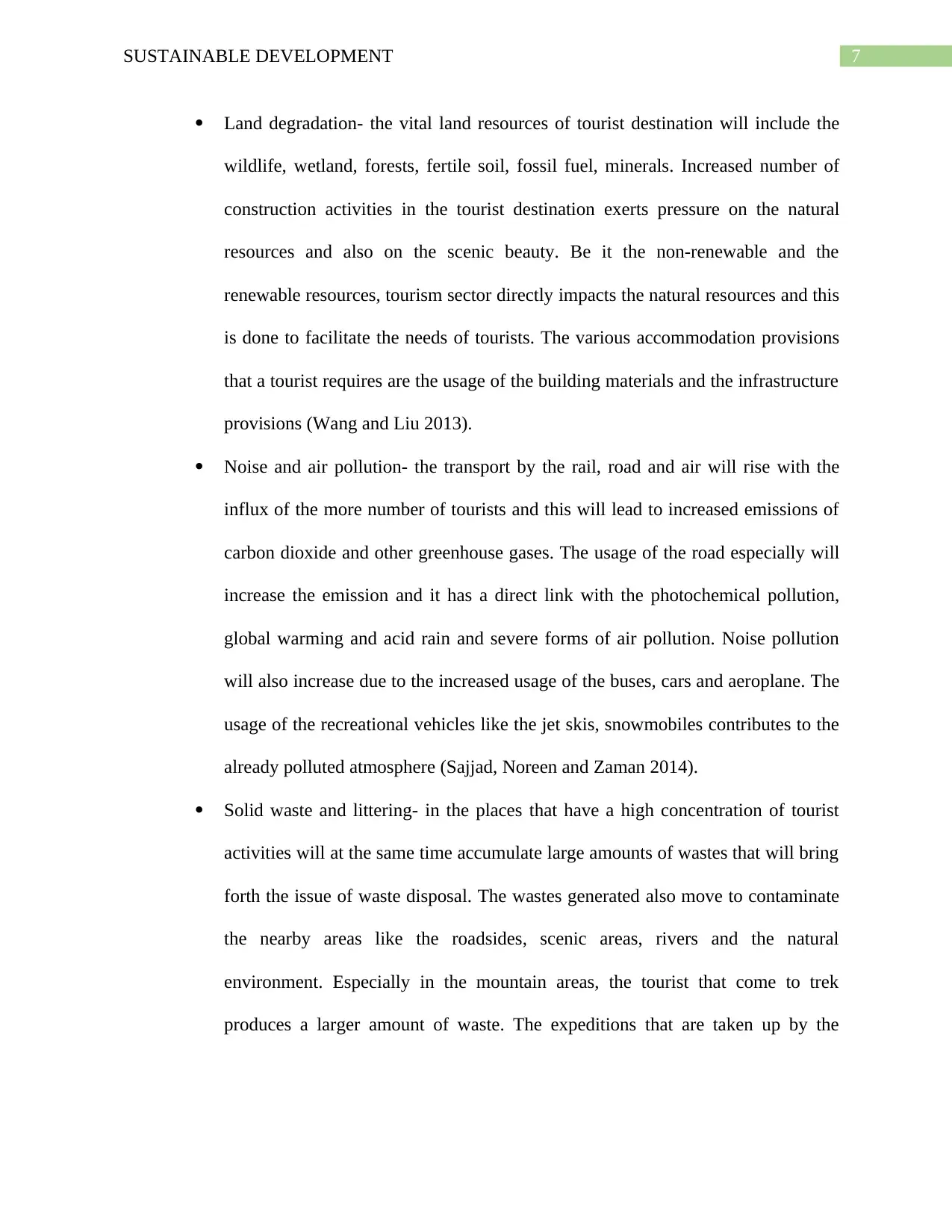
7SUSTAINABLE DEVELOPMENT
Land degradation- the vital land resources of tourist destination will include the
wildlife, wetland, forests, fertile soil, fossil fuel, minerals. Increased number of
construction activities in the tourist destination exerts pressure on the natural
resources and also on the scenic beauty. Be it the non-renewable and the
renewable resources, tourism sector directly impacts the natural resources and this
is done to facilitate the needs of tourists. The various accommodation provisions
that a tourist requires are the usage of the building materials and the infrastructure
provisions (Wang and Liu 2013).
Noise and air pollution- the transport by the rail, road and air will rise with the
influx of the more number of tourists and this will lead to increased emissions of
carbon dioxide and other greenhouse gases. The usage of the road especially will
increase the emission and it has a direct link with the photochemical pollution,
global warming and acid rain and severe forms of air pollution. Noise pollution
will also increase due to the increased usage of the buses, cars and aeroplane. The
usage of the recreational vehicles like the jet skis, snowmobiles contributes to the
already polluted atmosphere (Sajjad, Noreen and Zaman 2014).
Solid waste and littering- in the places that have a high concentration of tourist
activities will at the same time accumulate large amounts of wastes that will bring
forth the issue of waste disposal. The wastes generated also move to contaminate
the nearby areas like the roadsides, scenic areas, rivers and the natural
environment. Especially in the mountain areas, the tourist that come to trek
produces a larger amount of waste. The expeditions that are taken up by the
Land degradation- the vital land resources of tourist destination will include the
wildlife, wetland, forests, fertile soil, fossil fuel, minerals. Increased number of
construction activities in the tourist destination exerts pressure on the natural
resources and also on the scenic beauty. Be it the non-renewable and the
renewable resources, tourism sector directly impacts the natural resources and this
is done to facilitate the needs of tourists. The various accommodation provisions
that a tourist requires are the usage of the building materials and the infrastructure
provisions (Wang and Liu 2013).
Noise and air pollution- the transport by the rail, road and air will rise with the
influx of the more number of tourists and this will lead to increased emissions of
carbon dioxide and other greenhouse gases. The usage of the road especially will
increase the emission and it has a direct link with the photochemical pollution,
global warming and acid rain and severe forms of air pollution. Noise pollution
will also increase due to the increased usage of the buses, cars and aeroplane. The
usage of the recreational vehicles like the jet skis, snowmobiles contributes to the
already polluted atmosphere (Sajjad, Noreen and Zaman 2014).
Solid waste and littering- in the places that have a high concentration of tourist
activities will at the same time accumulate large amounts of wastes that will bring
forth the issue of waste disposal. The wastes generated also move to contaminate
the nearby areas like the roadsides, scenic areas, rivers and the natural
environment. Especially in the mountain areas, the tourist that come to trek
produces a larger amount of waste. The expeditions that are taken up by the
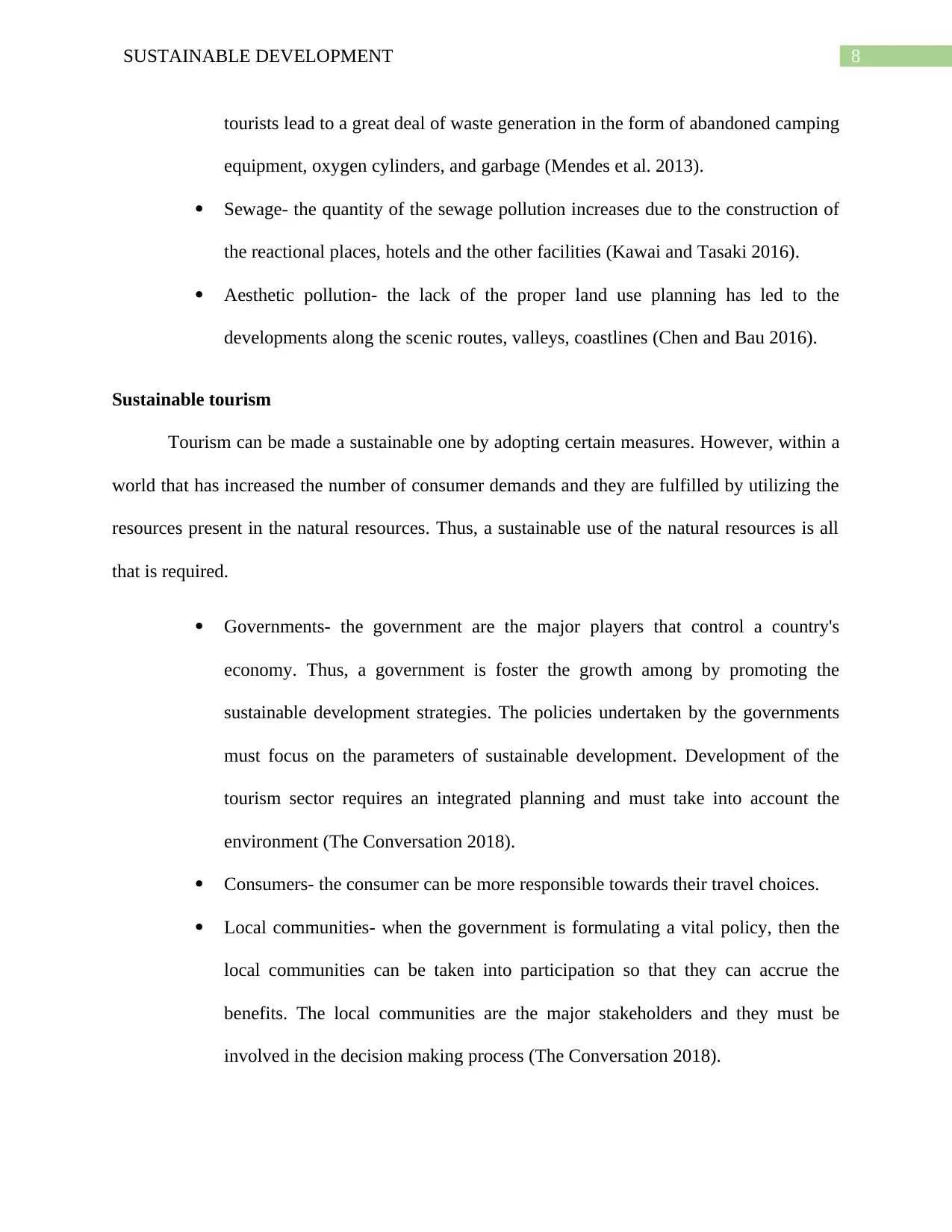
8SUSTAINABLE DEVELOPMENT
tourists lead to a great deal of waste generation in the form of abandoned camping
equipment, oxygen cylinders, and garbage (Mendes et al. 2013).
Sewage- the quantity of the sewage pollution increases due to the construction of
the reactional places, hotels and the other facilities (Kawai and Tasaki 2016).
Aesthetic pollution- the lack of the proper land use planning has led to the
developments along the scenic routes, valleys, coastlines (Chen and Bau 2016).
Sustainable tourism
Tourism can be made a sustainable one by adopting certain measures. However, within a
world that has increased the number of consumer demands and they are fulfilled by utilizing the
resources present in the natural resources. Thus, a sustainable use of the natural resources is all
that is required.
Governments- the government are the major players that control a country's
economy. Thus, a government is foster the growth among by promoting the
sustainable development strategies. The policies undertaken by the governments
must focus on the parameters of sustainable development. Development of the
tourism sector requires an integrated planning and must take into account the
environment (The Conversation 2018).
Consumers- the consumer can be more responsible towards their travel choices.
Local communities- when the government is formulating a vital policy, then the
local communities can be taken into participation so that they can accrue the
benefits. The local communities are the major stakeholders and they must be
involved in the decision making process (The Conversation 2018).
tourists lead to a great deal of waste generation in the form of abandoned camping
equipment, oxygen cylinders, and garbage (Mendes et al. 2013).
Sewage- the quantity of the sewage pollution increases due to the construction of
the reactional places, hotels and the other facilities (Kawai and Tasaki 2016).
Aesthetic pollution- the lack of the proper land use planning has led to the
developments along the scenic routes, valleys, coastlines (Chen and Bau 2016).
Sustainable tourism
Tourism can be made a sustainable one by adopting certain measures. However, within a
world that has increased the number of consumer demands and they are fulfilled by utilizing the
resources present in the natural resources. Thus, a sustainable use of the natural resources is all
that is required.
Governments- the government are the major players that control a country's
economy. Thus, a government is foster the growth among by promoting the
sustainable development strategies. The policies undertaken by the governments
must focus on the parameters of sustainable development. Development of the
tourism sector requires an integrated planning and must take into account the
environment (The Conversation 2018).
Consumers- the consumer can be more responsible towards their travel choices.
Local communities- when the government is formulating a vital policy, then the
local communities can be taken into participation so that they can accrue the
benefits. The local communities are the major stakeholders and they must be
involved in the decision making process (The Conversation 2018).
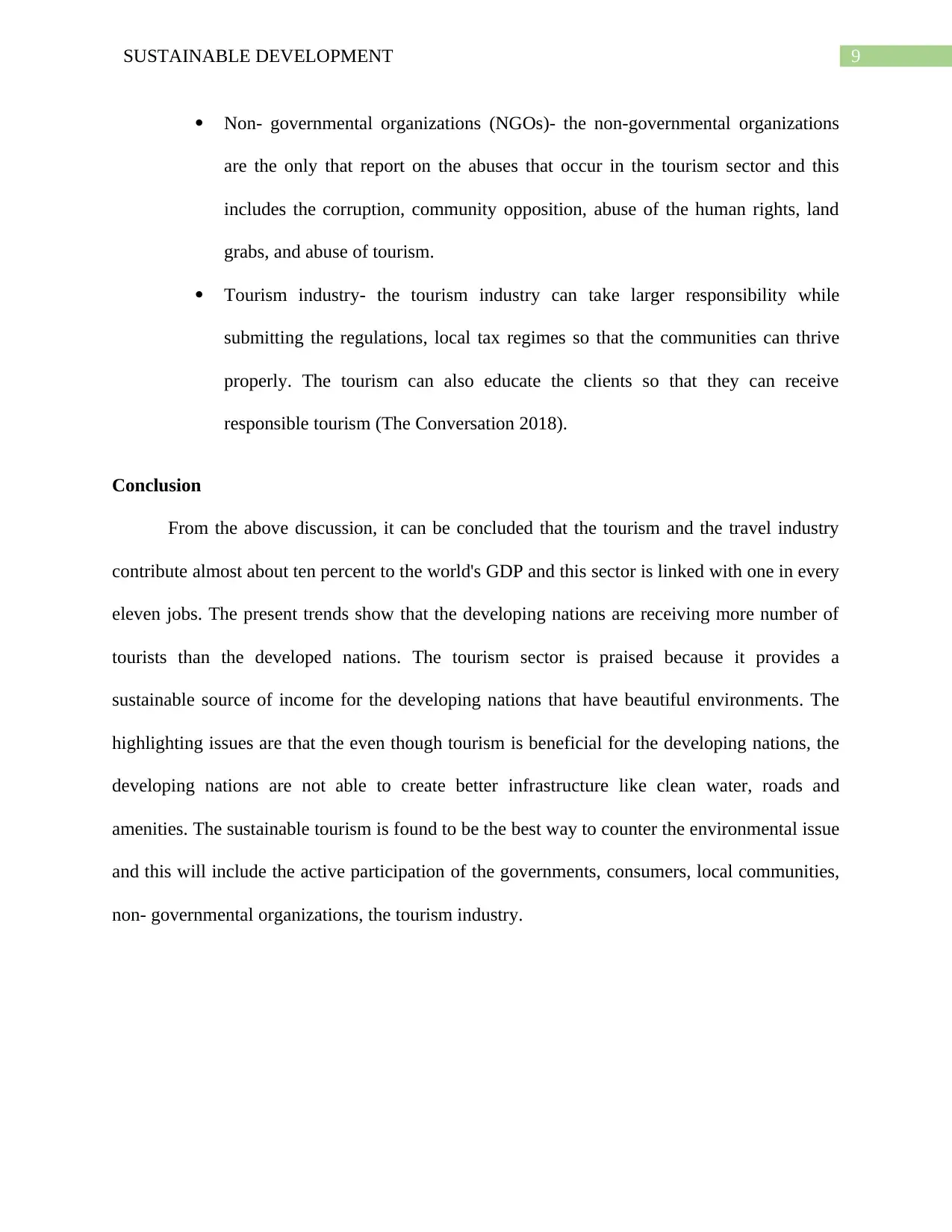
9SUSTAINABLE DEVELOPMENT
Non- governmental organizations (NGOs)- the non-governmental organizations
are the only that report on the abuses that occur in the tourism sector and this
includes the corruption, community opposition, abuse of the human rights, land
grabs, and abuse of tourism.
Tourism industry- the tourism industry can take larger responsibility while
submitting the regulations, local tax regimes so that the communities can thrive
properly. The tourism can also educate the clients so that they can receive
responsible tourism (The Conversation 2018).
Conclusion
From the above discussion, it can be concluded that the tourism and the travel industry
contribute almost about ten percent to the world's GDP and this sector is linked with one in every
eleven jobs. The present trends show that the developing nations are receiving more number of
tourists than the developed nations. The tourism sector is praised because it provides a
sustainable source of income for the developing nations that have beautiful environments. The
highlighting issues are that the even though tourism is beneficial for the developing nations, the
developing nations are not able to create better infrastructure like clean water, roads and
amenities. The sustainable tourism is found to be the best way to counter the environmental issue
and this will include the active participation of the governments, consumers, local communities,
non- governmental organizations, the tourism industry.
Non- governmental organizations (NGOs)- the non-governmental organizations
are the only that report on the abuses that occur in the tourism sector and this
includes the corruption, community opposition, abuse of the human rights, land
grabs, and abuse of tourism.
Tourism industry- the tourism industry can take larger responsibility while
submitting the regulations, local tax regimes so that the communities can thrive
properly. The tourism can also educate the clients so that they can receive
responsible tourism (The Conversation 2018).
Conclusion
From the above discussion, it can be concluded that the tourism and the travel industry
contribute almost about ten percent to the world's GDP and this sector is linked with one in every
eleven jobs. The present trends show that the developing nations are receiving more number of
tourists than the developed nations. The tourism sector is praised because it provides a
sustainable source of income for the developing nations that have beautiful environments. The
highlighting issues are that the even though tourism is beneficial for the developing nations, the
developing nations are not able to create better infrastructure like clean water, roads and
amenities. The sustainable tourism is found to be the best way to counter the environmental issue
and this will include the active participation of the governments, consumers, local communities,
non- governmental organizations, the tourism industry.
Secure Best Marks with AI Grader
Need help grading? Try our AI Grader for instant feedback on your assignments.
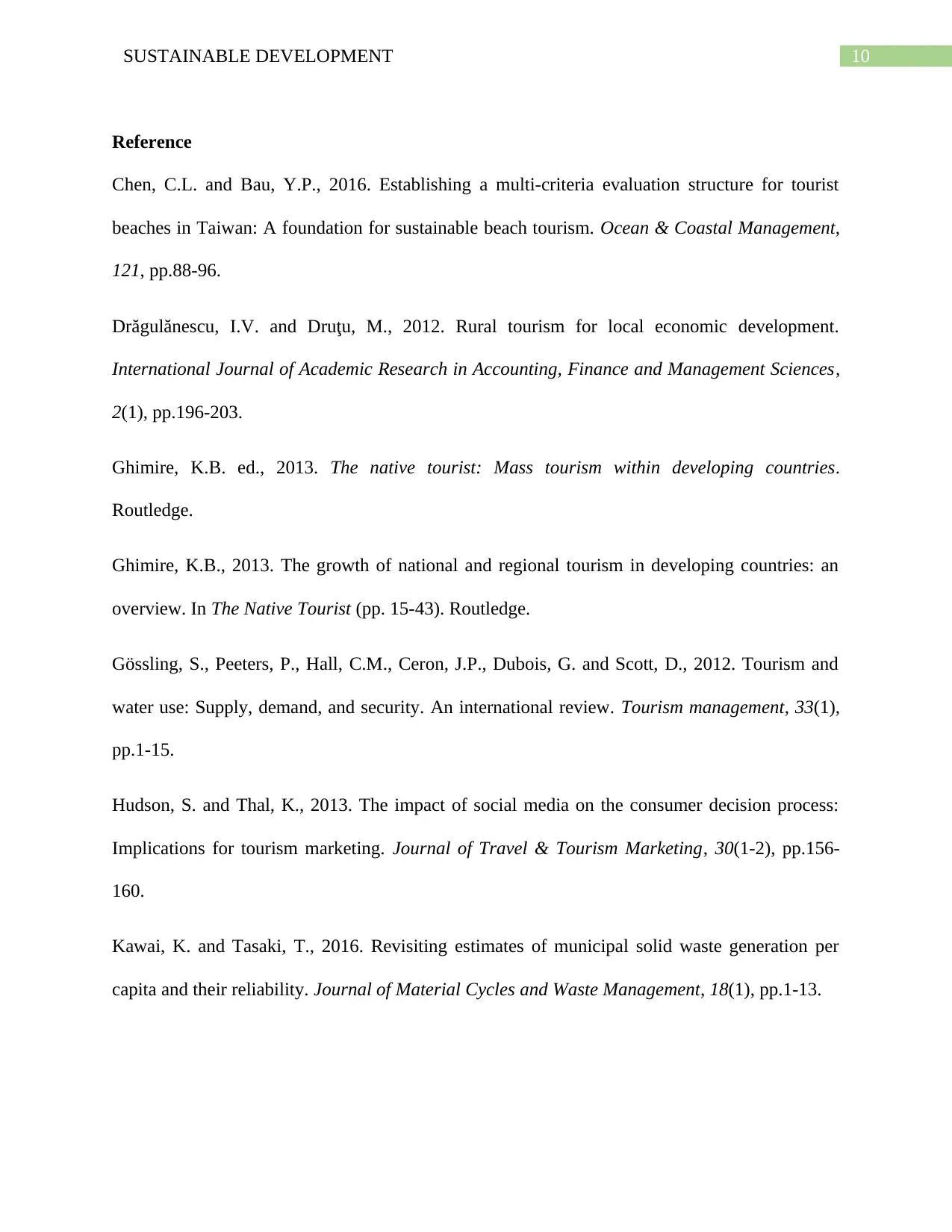
10SUSTAINABLE DEVELOPMENT
Reference
Chen, C.L. and Bau, Y.P., 2016. Establishing a multi-criteria evaluation structure for tourist
beaches in Taiwan: A foundation for sustainable beach tourism. Ocean & Coastal Management,
121, pp.88-96.
Drăgulănescu, I.V. and Druţu, M., 2012. Rural tourism for local economic development.
International Journal of Academic Research in Accounting, Finance and Management Sciences,
2(1), pp.196-203.
Ghimire, K.B. ed., 2013. The native tourist: Mass tourism within developing countries.
Routledge.
Ghimire, K.B., 2013. The growth of national and regional tourism in developing countries: an
overview. In The Native Tourist (pp. 15-43). Routledge.
Gössling, S., Peeters, P., Hall, C.M., Ceron, J.P., Dubois, G. and Scott, D., 2012. Tourism and
water use: Supply, demand, and security. An international review. Tourism management, 33(1),
pp.1-15.
Hudson, S. and Thal, K., 2013. The impact of social media on the consumer decision process:
Implications for tourism marketing. Journal of Travel & Tourism Marketing, 30(1-2), pp.156-
160.
Kawai, K. and Tasaki, T., 2016. Revisiting estimates of municipal solid waste generation per
capita and their reliability. Journal of Material Cycles and Waste Management, 18(1), pp.1-13.
Reference
Chen, C.L. and Bau, Y.P., 2016. Establishing a multi-criteria evaluation structure for tourist
beaches in Taiwan: A foundation for sustainable beach tourism. Ocean & Coastal Management,
121, pp.88-96.
Drăgulănescu, I.V. and Druţu, M., 2012. Rural tourism for local economic development.
International Journal of Academic Research in Accounting, Finance and Management Sciences,
2(1), pp.196-203.
Ghimire, K.B. ed., 2013. The native tourist: Mass tourism within developing countries.
Routledge.
Ghimire, K.B., 2013. The growth of national and regional tourism in developing countries: an
overview. In The Native Tourist (pp. 15-43). Routledge.
Gössling, S., Peeters, P., Hall, C.M., Ceron, J.P., Dubois, G. and Scott, D., 2012. Tourism and
water use: Supply, demand, and security. An international review. Tourism management, 33(1),
pp.1-15.
Hudson, S. and Thal, K., 2013. The impact of social media on the consumer decision process:
Implications for tourism marketing. Journal of Travel & Tourism Marketing, 30(1-2), pp.156-
160.
Kawai, K. and Tasaki, T., 2016. Revisiting estimates of municipal solid waste generation per
capita and their reliability. Journal of Material Cycles and Waste Management, 18(1), pp.1-13.
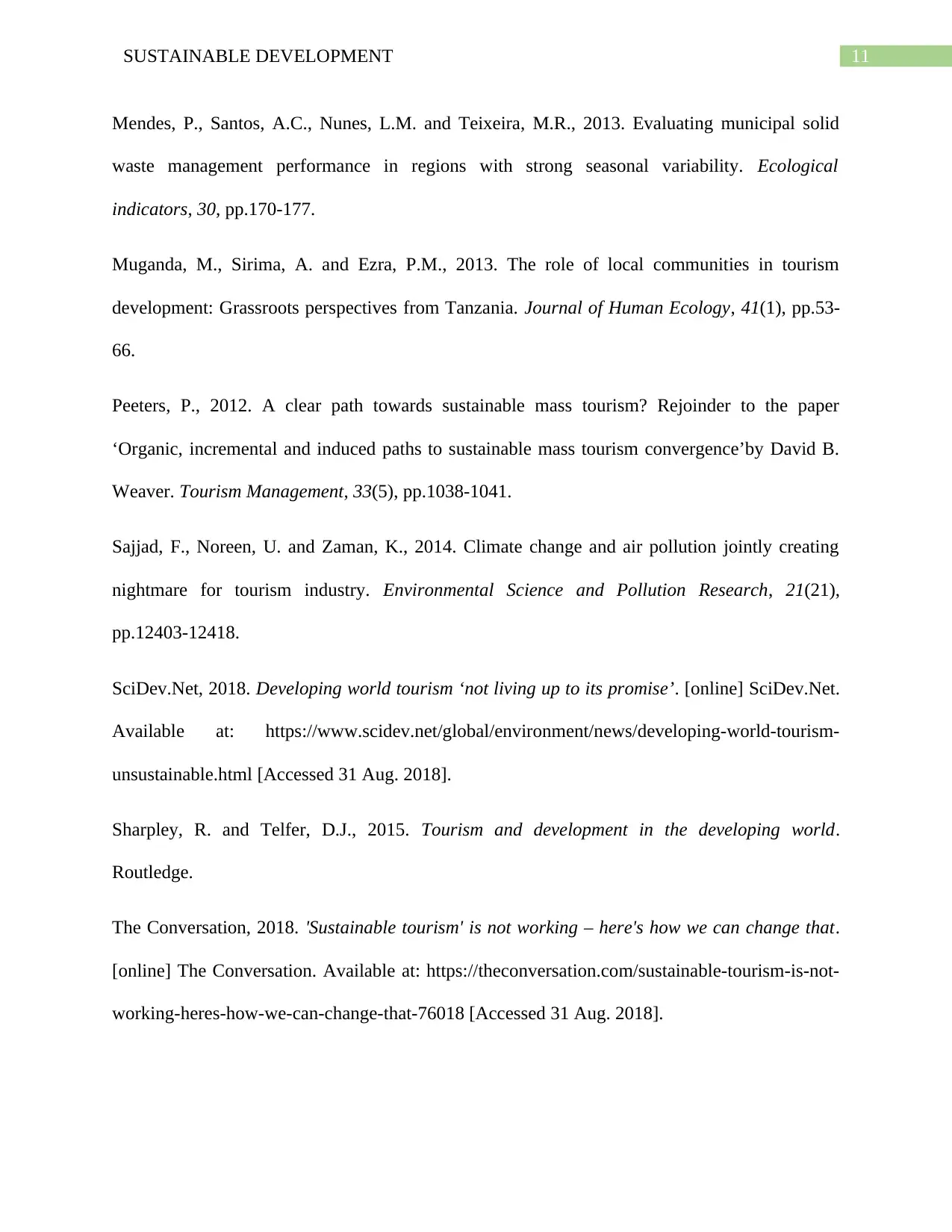
11SUSTAINABLE DEVELOPMENT
Mendes, P., Santos, A.C., Nunes, L.M. and Teixeira, M.R., 2013. Evaluating municipal solid
waste management performance in regions with strong seasonal variability. Ecological
indicators, 30, pp.170-177.
Muganda, M., Sirima, A. and Ezra, P.M., 2013. The role of local communities in tourism
development: Grassroots perspectives from Tanzania. Journal of Human Ecology, 41(1), pp.53-
66.
Peeters, P., 2012. A clear path towards sustainable mass tourism? Rejoinder to the paper
‘Organic, incremental and induced paths to sustainable mass tourism convergence’by David B.
Weaver. Tourism Management, 33(5), pp.1038-1041.
Sajjad, F., Noreen, U. and Zaman, K., 2014. Climate change and air pollution jointly creating
nightmare for tourism industry. Environmental Science and Pollution Research, 21(21),
pp.12403-12418.
SciDev.Net, 2018. Developing world tourism ‘not living up to its promise’. [online] SciDev.Net.
Available at: https://www.scidev.net/global/environment/news/developing-world-tourism-
unsustainable.html [Accessed 31 Aug. 2018].
Sharpley, R. and Telfer, D.J., 2015. Tourism and development in the developing world.
Routledge.
The Conversation, 2018. 'Sustainable tourism' is not working – here's how we can change that.
[online] The Conversation. Available at: https://theconversation.com/sustainable-tourism-is-not-
working-heres-how-we-can-change-that-76018 [Accessed 31 Aug. 2018].
Mendes, P., Santos, A.C., Nunes, L.M. and Teixeira, M.R., 2013. Evaluating municipal solid
waste management performance in regions with strong seasonal variability. Ecological
indicators, 30, pp.170-177.
Muganda, M., Sirima, A. and Ezra, P.M., 2013. The role of local communities in tourism
development: Grassroots perspectives from Tanzania. Journal of Human Ecology, 41(1), pp.53-
66.
Peeters, P., 2012. A clear path towards sustainable mass tourism? Rejoinder to the paper
‘Organic, incremental and induced paths to sustainable mass tourism convergence’by David B.
Weaver. Tourism Management, 33(5), pp.1038-1041.
Sajjad, F., Noreen, U. and Zaman, K., 2014. Climate change and air pollution jointly creating
nightmare for tourism industry. Environmental Science and Pollution Research, 21(21),
pp.12403-12418.
SciDev.Net, 2018. Developing world tourism ‘not living up to its promise’. [online] SciDev.Net.
Available at: https://www.scidev.net/global/environment/news/developing-world-tourism-
unsustainable.html [Accessed 31 Aug. 2018].
Sharpley, R. and Telfer, D.J., 2015. Tourism and development in the developing world.
Routledge.
The Conversation, 2018. 'Sustainable tourism' is not working – here's how we can change that.
[online] The Conversation. Available at: https://theconversation.com/sustainable-tourism-is-not-
working-heres-how-we-can-change-that-76018 [Accessed 31 Aug. 2018].
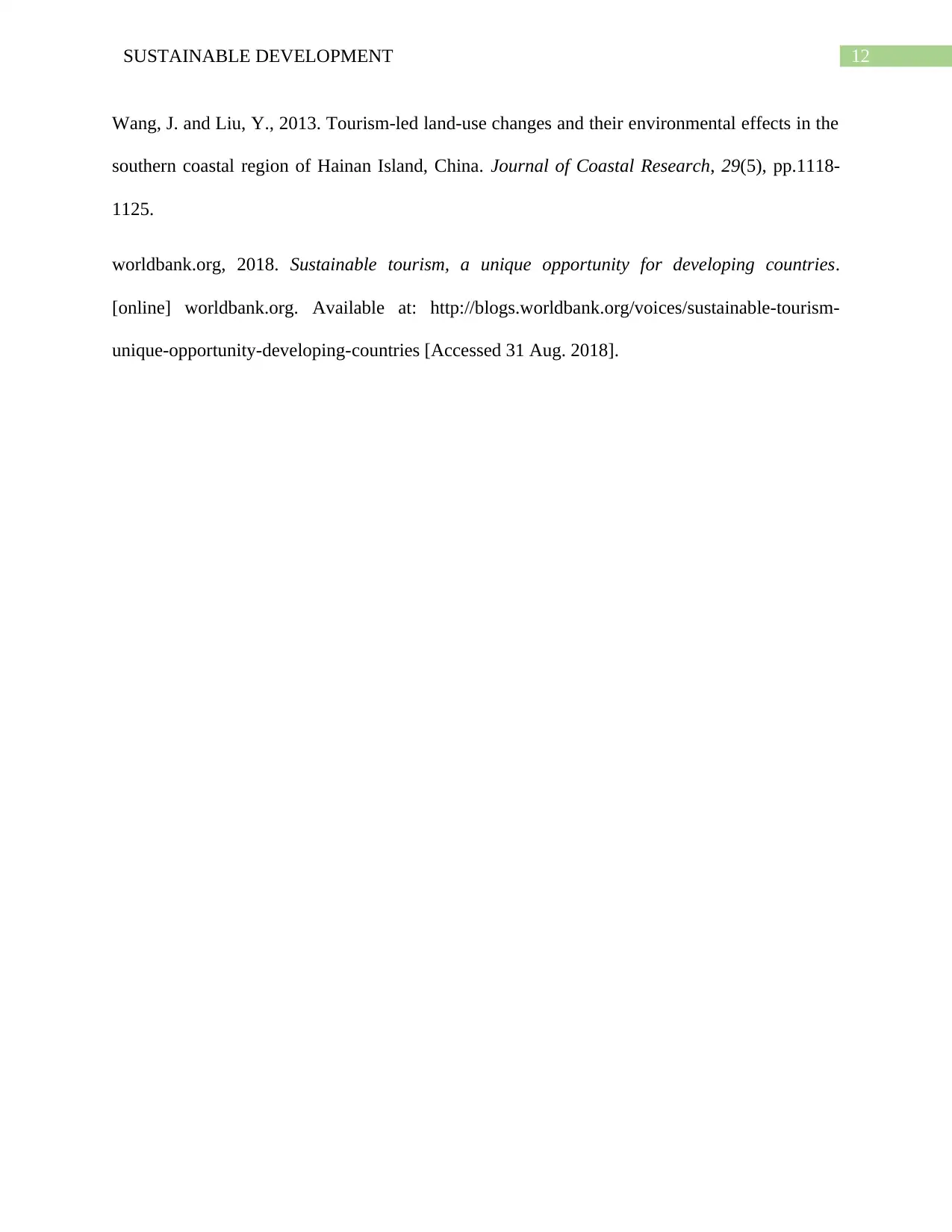
12SUSTAINABLE DEVELOPMENT
Wang, J. and Liu, Y., 2013. Tourism-led land-use changes and their environmental effects in the
southern coastal region of Hainan Island, China. Journal of Coastal Research, 29(5), pp.1118-
1125.
worldbank.org, 2018. Sustainable tourism, a unique opportunity for developing countries.
[online] worldbank.org. Available at: http://blogs.worldbank.org/voices/sustainable-tourism-
unique-opportunity-developing-countries [Accessed 31 Aug. 2018].
Wang, J. and Liu, Y., 2013. Tourism-led land-use changes and their environmental effects in the
southern coastal region of Hainan Island, China. Journal of Coastal Research, 29(5), pp.1118-
1125.
worldbank.org, 2018. Sustainable tourism, a unique opportunity for developing countries.
[online] worldbank.org. Available at: http://blogs.worldbank.org/voices/sustainable-tourism-
unique-opportunity-developing-countries [Accessed 31 Aug. 2018].
1 out of 13
Related Documents
Your All-in-One AI-Powered Toolkit for Academic Success.
+13062052269
info@desklib.com
Available 24*7 on WhatsApp / Email
![[object Object]](/_next/static/media/star-bottom.7253800d.svg)
Unlock your academic potential
© 2024 | Zucol Services PVT LTD | All rights reserved.





